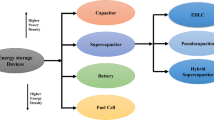Abstract
The popular inlaid disc electrode suffers from an edge effect that is usually, and sometimes unwarrantedly, ignored in analyzing transient voltammograms. This study addresses the role played by the edge in linear scan and cyclic voltammetries when the electron transfer is reversible or quasi-reversible. A simulation models the concentrations, current densities and currents in two circumstances—when the edge in important and when it is absent—simultaneously, and thereby the evolving edge current is quantified. Special attention is paid to the effect that the edge has on the heights and positions of the voltammetric peaks. It is demonstrated that disregarding the edge may lead to the bogus classification of a reversible electrode reaction as quasi-reversible.







Similar content being viewed by others
References
Bond AM, Luscombe DL, Oldham KB, Zoski CG (1988) J Electroanal Chem 249:1
Myland JC, Oldham KB (2009) J Solid State Electrochem 13:521
Oldham KB, Myland JC (2005) J Electroanal Chem 576:353
Cottrell FC (1903) Z Phys Chem 42:385
Mahon PJ, Oldham KB (2005) Anal Chem 77:6100
Marken F, Neudeck A, Bond AM (2010) In: Scholz F (ed) Electroanalytical methods. Springer, Heidelberg
Myland JC, Oldham KB (2005) J Electroanal Chem 575:81
Oldham KB, Feldberg SW (1999) J Phys Chem B 103:1699
Randles JEB (1946) Trans Faraday Soc 44:327
Ševčik A (1948) Collect Czechoslov Chem Commun 13:349
Reinmuth WH (1964) Anal Chem 36:211
Oldham KB (1979) J Electroanal Chem 105:373
Myland JC, Oldham KB (1983) J Electroanal Chem 153:43
Bard AJ, Faulkner LR (2001) Electrochemical methods. Wiley, New York, 785
Britz D (2005) Digital simulation in electrochemistry. Springer, Berlin
Michael AC, Wightman RM, Amatore CA (1989) J Electroanal Chem 267:33
Rudolph M http://www.elchsoft.com/digielch
Oldham KB, Myland JC, Bond AM (2012) Electrochemical science and technology. Wiley, Chichester, p 346
Nicholson RS, Shain I (1964) Anal Chem 36:706
Nicholson RS (1965) Anal Chem 37:1351
Bard AJ, Faulkner LR (2001) Electrochemical methods. Wiley, New York, p 242
Simonov AN, Mashkina EA, Mahon PJ, Oldham KB, Bond AM (2015) J Electroanal Chem in preparation
Author information
Authors and Affiliations
Corresponding author
Additional information
In recognition of the 65th birthday of Stephen Fletcher, an insightful scientist and dear friend.
Appendices
Appendix A
Here, we demonstrate that the approximations represented by the terms on right-hand side of Eq. (4:1) may be justified by assuming that quadratic equations link the dependent variable c P to each of the spatial variables, r and z.
Consider the dependence of the product concentration c P on the vertical coordinate z, at constant values of the r and t variables. Assume that, in the immediate vicinity of a particular value of z, say within the region between Z − Δ and Z + Δ, the relationship between concentration and distance may be represented by the quadratic equation
with w 0, w 1 and w 2 being local constants. Note the distinction between Z, a particular value of the coordinate, and z, which here is any value of the coordinate close to Z. In addition to
two similar equations also apply; these differ from A:2 in having Z replaced by Z − Δ or Z + Δ. The three w coefficients may now be found by solving the trio of equations simultaneously. When the results of this exercise are substituted back into Eq. (A:1), the relation
emerges. This fitted quadratic equation describes how c P depends on z in the vicinity of z = Z.
Equation (A:3) may be differentiated once:
and twice:
Equations (A:4) and (A:5) apply for any value of z close to Z including, of course, when z = Z. In the latter eventuality, the equations reduce to
and
This derivation of Eq. (A:7) is a vindication of the final term in approximation 4:1. Likewise, the penultimate term in 4:1 is justified by the radial equivalent of Eq. (A:6).
This appendix is not presented for its own sake; most readers will accept approximations 4:1 without algebraic justification. Rather, the above algebra provides a preamble to the derivation that follows.
Appendix B
Equation (A:3) was derived by fitting a quadratic through the three points z = Z − Δ, z = Z and z = Z + Δ. If we repeat the procedure, but instead fit the quadratic to the three unevenly spaced points \( z=0,\kern0.24em z={\scriptscriptstyle \frac{1}{2}}\varDelta \kern0.24em \operatorname{and}\kern0.24em z={\scriptscriptstyle \frac{3}{2}}\varDelta, \) the analogue of Eq. (A:3) turns out to be
The first and second derivatives are
and
These are the equations that we use to replace (A:6) and (A:7) close to z = 0 boundary.
When that boundary is with the electrode, Eq. (B:3) provides a means of discretizing the final term in Eq. (2:2). Thereby, a replacement for Eq. (4:1), valid for \( 0\le z\le {\scriptscriptstyle \frac{3}{2}}\varDelta, \) is
After choosing z = \( {\scriptscriptstyle \frac{1}{2}}\varDelta, \) discretization and rearrangement, Eq. (5:3) of the main text results.
On the insulator surface, the flux of product is zero, enabling the z = 0 instance of Eq. (B:2) to yield the identity
On conversion to the discrete notation, this becomes Eq. (5:7) of the main text.
Equation (B:2) provides one expression, namely
for the gradient of the product concentration at z = 0; the boundary condition on the electrode surface, Eq. (2:7), provides another. Combining these two expressions to eliminate the concentration gradient leads to the result
that interrelates three contemporaneous concentrations. Equation (5:6) of the main text is the discrete version of this equation, after rearrangement.
Rights and permissions
About this article
Cite this article
Myland, J.C., Oldham, K.B. The excess current in cyclic voltammetry arising from the presence of an electrode edge. J Solid State Electrochem 18, 3259–3269 (2014). https://doi.org/10.1007/s10008-014-2652-3
Received:
Revised:
Accepted:
Published:
Issue Date:
DOI: https://doi.org/10.1007/s10008-014-2652-3




